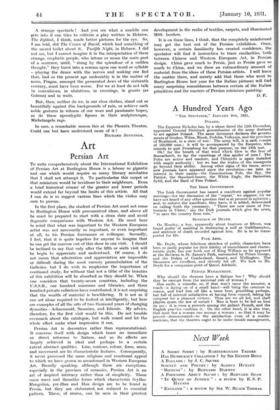Art
Persian Art
To write comprehensively about the International Exhibition of Persian Art at Burlington House is a labour so gigantic and one which would require so many literary acrobatics that I shall not attempt it. To particularize this carpet or that miniature would be invidious to their neighbours. Even a brief historical resume of the greater and lesser periods would extend far beyond the limits of this article. All that I can do is to suggest various lines which the visitor may care to pursue.
In the first place, the student of Persian Art must not come to Burlington House with preconceived ideas, and above all he must be prepared to start with a clean slate and avoid dogmatic comparisons with Western Art. He must bear in mind that what was important to the Western European artist was not necessarily so important, or even important at all, to his Persian forerunner or colleague. Secondly, I feel, that it is quite hopeless for anyone to imagine that he can get the marrow out of this show in one visit. I should be inclined to say that only after the fifth or sixth visit will he begin to appreciate and understand. Of course, I do not mean that admiration and appreciation are impossible or difficult during the most cursory perambulation of the Galleries, but I do wish to emphasize the importance of continued study, for without that not a tithe of the beauties of this exhibition will be absorbed as they should be. When one considers that twenty-seven countries, including the U.S.S.R., one hundred museums and libraries, and three hundred private collectors have contributed, it is not surprising that the wealth of material is bewildering. It is not as if one art alone required to be looked at intelligently, but here are examples of all the arts of two thousand years of changing dynasties—Achaemenid, Sasanian, and Islamic. My advice, therefore, for the first visit would be this. Do not trouble overmuch about the catalogue, but walk round and let the whole effect make what impression it can.
Persian Art is decorative rather than representational. It concerns itself with design which bears no immediate or direct reference to Nature, and so its effects are largely achieved in ideal and perhaps to a certain extent abstract qualities. Line, contour, colour, form, mass, and movement are its characteristic features. Consequently, it never possessed the same religious and emotional appeal to which we have grown so accustomed in Western European Art. Broadly speaking, although there are exceptions, especially in the province of ceramics, Persian Art is an art of inspired intricacy rather than of simplicity. Those Fame wave and flamelike forms which characterize Scytho- Mongolian, pre-Han and Han design are to be found in Persia, but they are elaborated, not reduced to essential pattern. These, of course, can be seen in their greatest
development in the realm of textiles, carpets, and illuminated MSS. 'borders.
It is on these lines, I think, that the completely uninformed may get the best out of the Persian exhibition. Once, however, a certain familiarity has created confidence, the spectator will find it instructive to trace similarities, both between Chinese and Western European Art, in Persian design. China gave much to Persia, just as Persia gave so much to China, and we drew an extraordinary amount of material from the ideas of these Persian artists. I will leave the matter there, and merely add that those who went to Burlington House last year for the Italian pictures will find many surprising resemblances between certain of the Italian primitives and the masters of Persian miniature painting.
D. F.


































 Previous page
Previous page